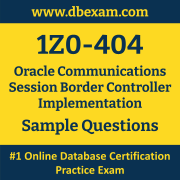01. The SBC rejects a configuration activation due to unresolved dependencies. Which two issues commonly trigger this failure?
(Choose two.)
a) System logs exceeding storage limit
b) Inactive VLAN interfaces
c) Realm references to deleted SIP interfaces
d) Session agent entries with missing IP addresses
e) A codec policy missing assigned codecs
02. An SBC receives a SIP REGISTER request with a Contact header containing a private IP address. Why does the SBC modify this header before forwarding it?
a) To enforce SIP interface MTU limits
b) To ensure proper NAT traversal for the registration
c) To apply VLAN filtering rules
d) To rewrite codec preferences for the endpoint
03. When modifying configuration elements under the SIP interface section, the SBC warns that the element is “in use.” What is the typical implication?
a) The configuration is referenced by active realms or agents
b) The VLAN trunk is not negotiated yet
c) The HA sync is interfering with the change
d) The SRTP policy is not applied correctly
04. An engineer assigns an IP address to a physical interface, but the SBC does not respond to ping on that address. Which condition most commonly explains this behavior?
a) The SIP interface has not been assigned a policy route
b) The codec policy is not applied to the steering pool
c) Management-access is disabled on the interface
d) The SRTP profile is missing mandatory parameters
05. After boot, the SBC displays system services in a “running with warnings” state. What is a common reason for this status?
a) Missing optional configuration elements
b) Peering realm links overloaded
c) Excessive RTP crypto suites
d) VLAN spanning tree mismatches
06. A SIP INVITE enters the SBC from the access realm, but no response is sent to the caller. The session agent associated with the target provider is reachable. Which condition most commonly prevents the SBC from forwarding the request?
a) The VLAN tagging is configured on the wrong subnet
b) The routing policy does not match the ingress realm
c) The HA standby node is overriding the active node
d) The codec group is not applied to the media interface
07. After creating multiple VLAN subinterfaces, the SBC shows traffic leaking between VLANs. What is a likely configuration issue?
a) Overlapping subnet definitions
b) Excessive codec groups
c) Disabled HNT profiles
d) Unassigned SIP interface modes
08. During troubleshooting, an engineer sees multiple “408 Request Timeout” responses. What is the most typical trigger?
a) The SIP interface is configured with too many codecs
b) The SBC is missing a default VLAN route
c) The media flows are using asymmetric paths
d) The next-hop session agent is unreachable
09. Which two SIP elements are used by the SBC to match ongoing dialog messages to the correct session?
(Choose two.)
a) Call-ID
b) VLAN identifier
c) From/To tags
d) Steering pool ID
e) System serial number
10. A technician wants to compare the current running configuration with a saved offline configuration file. Which ACLI feature is designed for this task?
a) show-system
b) compare-config
c) show-network
d) reset-config
 The Oracle Communications Session Border Controller Implementation (1Z0-404) Sample Question Set is designed to help you prepare for the Oracle Communications Session Border Controller Basic Certified Implementation Professional certification exam. To become familiar with the actual Oracle Certification exam environment, we suggest you try our Sample Oracle 1Z0-404 Certification Practice Exam.
The Oracle Communications Session Border Controller Implementation (1Z0-404) Sample Question Set is designed to help you prepare for the Oracle Communications Session Border Controller Basic Certified Implementation Professional certification exam. To become familiar with the actual Oracle Certification exam environment, we suggest you try our Sample Oracle 1Z0-404 Certification Practice Exam.